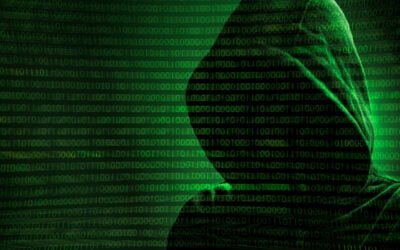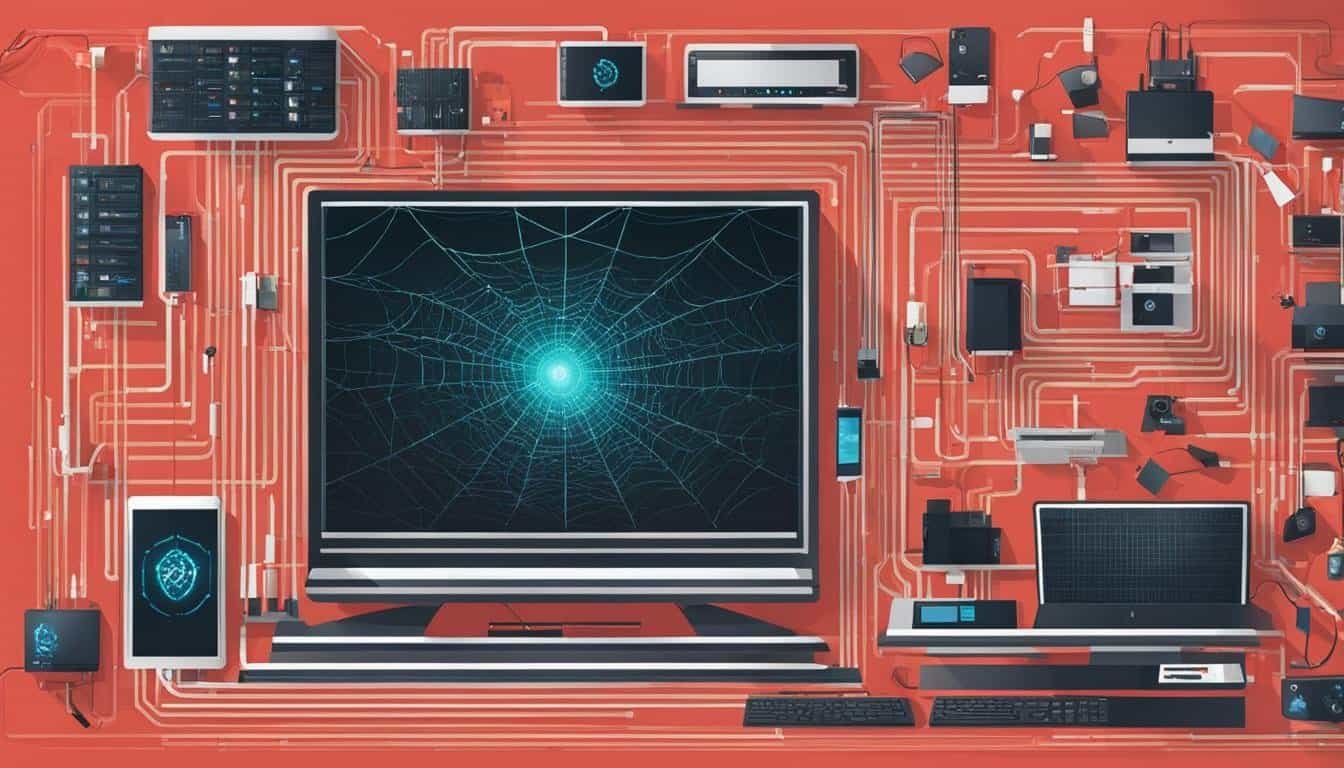Welcome to our article on hacking laws and why hacking is considered illegal under U.S. law. In today’s digital age, where we rely heavily on technology, it’s vital to understand the legal implications of hacking and the consequences it can have. Let’s dive into the details and explore the reasons behind the illegality of hacking in the United States.
Key Takeaways:
- Hacking is illegal under U.S. law due to federal and state hacking laws.
- The Computer Fraud and Abuse Act (CFAA) is the primary federal law governing hacking offenses.
- Engaging in hacking activities can lead to criminal charges and severe penalties.
- There are legal forms of hacking that serve legitimate purposes, such as research hacking and bug bounty programs.
- Risks of retaliatory hacking, or hack-back, include cyber vigilantism and potential collateral damage.
The Computer Fraud and Abuse Act (CFAA)
The Computer Fraud and Abuse Act (CFAA) is a crucial federal law that specifically addresses unauthorized access to computer systems and networks. Enacted in 1986, the CFAA was originally designed to protect government and financial institutions from cybercrime. However, its scope has expanded over the years to encompass virtually all types of computers, including laptops, smartphones, and commercial servers. Under the CFAA, engaging in hacking activities that involve unauthorized access to someone else’s computer is considered illegal.
The CFAA serves as the primary legal framework for prosecuting hacking offenses in the United States. It prohibits individuals from knowingly accessing protected computers without authorization and obtaining information from these computers. The law also criminalizes the transmission of malicious code, launching denial-of-service attacks, and any other actions that may cause damage or disruption to computer systems. Violations of the CFAA can result in criminal charges and severe penalties, including fines and imprisonment.
The CFAA plays a critical role in deterring cybercrime and protecting individuals and organizations from unauthorized access to their computer systems. By establishing clear legal boundaries, the CFAA helps maintain the integrity of digital networks and safeguards sensitive information from hackers. However, it is essential to stay updated on the evolving nature of hacking and cyber threats to ensure that the CFAA remains effective in combating cybercrime.
The Computer Fraud and Abuse Act (CFAA) is the cornerstone of hacking laws in the United States, providing a robust legal framework to combat unauthorized access and other cybercrimes. Understanding the provisions and implications of the CFAA is crucial in promoting a safer digital environment for individuals and businesses alike.
Types of Activities Considered Computer Hacking
When it comes to computer hacking, there are various activities that are considered illegal under the Computer Fraud and Abuse Act (CFAA) and other hacking laws. These activities involve unauthorized access to computer systems and networks, and they can have severe consequences for individuals who engage in them. Some of the types of activities considered computer hacking include:
- Damage or deletion of computer data: This involves intentionally causing harm to computer systems by deleting or altering data, which can disrupt operations and potentially result in financial losses.
- Sending spam: The unauthorized sending of unsolicited emails or messages, often for the purpose of spreading malware or phishing for personal information.
- Buying or selling computer passwords or information: Engaging in illegal activities such as identity theft by trading or selling stolen passwords or personal information obtained through hacking.
- Obtaining information without authorization: This involves accessing sensitive or confidential information from a computer or network without permission, which can lead to privacy breaches and potential harm to individuals or organizations.
These are just a few examples of the types of activities that are considered computer hacking offenses. It’s important to note that hacking laws can vary by jurisdiction, and specific actions may be defined differently depending on the legal framework in place. However, in general, unauthorized access to computer systems and the misuse of data are considered serious offenses that can result in criminal charges and significant penalties.
New York Hacking Laws: Understanding Article 156 of Title J
When it comes to hacking laws, each state in the United States has its own set of regulations in addition to federal laws. In New York, hacking offenses are covered under Article 156 of Title J, which encompasses a range of computer-related offenses. This article aims to address unauthorized use of a computer, computer tampering, unlawful duplication of computer-related material, and operating unlawful electronic sweepstakes. Understanding the specifics of these laws is crucial in combating cybercrime and ensuring the safety of individuals and businesses.
Article 156 of Title J offers a comprehensive framework for dealing with computer-related offenses in New York. It criminalizes activities such as gaining unauthorized access to computer systems, altering computer data, and using computers to commit fraud. The law also covers offenses related to intellectual property theft and the unlawful duplication of computer-related materials. By explicitly defining these offenses, the legislation provides clarity on what constitutes illegal hacking activities in the state of New York.
With the rapid advancement of technology, it is essential that legislation keeps pace to address emerging cyber threats effectively. New York’s hacking laws, as outlined in Article 156 of Title J, demonstrate the state’s commitment to combatting cybercrime and protecting its residents. By understanding and enforcing these laws, law enforcement agencies can effectively prosecute hackers who engage in criminal activities, safeguarding both individuals and businesses from the detrimental effects of cyberattacks.
Table: Overview of Computer-Related Offenses under Article 156 of Title J
| Offense | Potential Penalty |
|---|---|
| Unauthorized use of a computer | Felony punishable by imprisonment and fines |
| Computer tampering | Felony punishable by imprisonment and fines |
| Unlawful duplication of computer-related material | Misdemeanor punishable by imprisonment and fines |
| Operating unlawful electronic sweepstakes | Misdemeanor punishable by imprisonment and fines |
Table: Overview of Computer-Related Offenses under Article 156 of Title J
Penalties for Hacking Crimes
In the United States, hacking crimes carry significant penalties, including fines and prison sentences. The severity of the punishment depends on the specific hacking offense committed and the impact it has on individuals, organizations, or national security. Here are some examples of the penalties associated with hacking crimes:
| Hacking Offense | Penalties |
|---|---|
| Trafficking in passwords or unauthorized access | Large fines or 1-5 years in prison |
| Accessing government national security information | Up to 10 years in prison |
| Hacking with broader violations of national security or wire fraud laws | Even more severe consequences |
It’s important to note that these penalties are not exhaustive and can vary depending on the jurisdiction and specific circumstances of the hacking offense. Judges have discretion in sentencing, taking into account factors such as the defendant’s criminal history, the magnitude of harm caused, and the level of sophistication involved in the hacking activity.
Furthermore, hacking offenses can also lead to civil liabilities, where victims can seek compensation for damages caused by the hacking activity. This can include financial losses, reputational damages, and costs associated with remediation and strengthening cybersecurity measures.
Legal Forms of Hacking

When it comes to hacking, not all activities are illegal. In fact, there are legal forms of hacking that serve legitimate purposes in enhancing cybersecurity. These legal forms of hacking require authorization and play a crucial role in identifying vulnerabilities and improving defenses against cyber threats.
One example of legal hacking is research hacking. This involves using passive techniques to gather information and understand vulnerabilities in computer systems. Researchers employ ethical hacking practices to identify weaknesses and provide valuable insights to organizations, helping them strengthen their security measures.
Another legal form of hacking is through bug bounty programs. In these programs, organizations encourage ethical hackers to expose vulnerabilities in their systems by offering rewards or bounties. This incentivizes individuals to report potential security flaws, allowing companies to proactively address these issues before they can be exploited by malicious hackers.
Professional penetration testing is also a legal form of hacking. Security professionals are hired to simulate real-world cyber attacks on a company’s systems, identifying vulnerabilities and providing recommendations to enhance security. This proactive approach helps organizations stay one step ahead of potential threats and strengthens their overall cybersecurity posture.
Legal hacking plays a crucial role in improving cybersecurity practices. By authorizing and regulating specific hacking activities, organizations and individuals can stay ahead of cyber threats and protect sensitive information.
Risks of Hack-Back
Retaliatory hacking, also known as hack-back, poses significant risks that have led to strong opposition from cybersecurity experts and legal authorities. While the idea of fighting fire with fire may seem appealing, the potential consequences outweigh the perceived benefits. Here, we explore the risks associated with hack-back.
1. Cyber Vigilantism
Hack-back can pave the way for cyber vigilantism, where private entities take the law into their own hands without proper oversight and due process. Allowing individuals or organizations to engage in retaliatory hacking creates a dangerous precedent, encouraging a “wild west” mentality in cyberspace. Such unregulated actions can lead to unintended consequences and undermine the rule of law.
2. Collateral Damage
One of the most significant risks of hack-back is the potential for collateral damage. Retaliatory hacking can involve compromising third-party computers and networks that may be unwittingly connected to the target. Innocent individuals or organizations could become collateral victims of the attack, leading to financial losses, reputational damage, and potential legal implications.
3. International Implications
Engaging in hack-back against nation-state actors or in cross-border cyberattacks can have serious international implications. Retaliatory actions can escalate conflicts, strain diplomatic relations, and lead to unintended consequences in an already complex global cybersecurity landscape. The potential for retaliatory cycles of hacking could fuel a never-ending cycle of cyber warfare.
Table: Risks of Hack-Back
| Risk | Description |
|---|---|
| Cyber Vigilantism | Private entities taking law enforcement into their own hands without due process. |
| Collateral Damage | Innocent third parties becoming unintended victims of retaliatory hacking. |
| International Implications | Potential escalation of conflicts and strain on diplomatic relations. |
Distinguishing Types of Counterhacks
Counterhacking techniques encompass a range of strategies and tools used to respond to cyber threats and protect computer systems. These techniques can be distinguished based on their severity and benefits, providing a nuanced approach to cybersecurity. By understanding the different types of counterhacks, organizations and individuals can make informed decisions about their defensive strategies.
High-Utility Counterhacks
High-utility counterhacks are effective techniques that provide valuable information without causing significant damage. These include cyber beacons, which are small pieces of code embedded within computer systems to track attackers and monitor their activities. Cyber beacons allow organizations to gather crucial intelligence about potential threats and take appropriate action to secure their systems.
Dye packets are another example of a high-utility counterhack. These packets contain encrypted data that appears legitimate to attackers, but when accessed, triggers an alert and provides valuable information about the attacker’s location and identity. This helps organizations identify and respond to threats effectively.
Medium-Utility Counterhacks
Medium-utility counterhacks involve more intrusion and potential damage to attackers. Keyloggers, for example, record keystrokes made by an unauthorized user, capturing sensitive information such as usernames, passwords, and other valuable data. This can provide crucial evidence for identifying attackers and preventing further breaches.
Booby traps are another medium-utility technique used to catch hackers. These traps are designed to look and act like legitimate files or systems, but when accessed, they trigger an alert and notify the organization of an attempted breach. While effective, it’s important for organizations to exercise caution when using booby traps to avoid accidentally harming innocent users or triggering false alarms.
Low-Utility Counterhacks
Low-utility counterhacks are offensive techniques that are not justified in most scenarios and should generally be avoided. These include Distributed Denial of Service (DDoS) attacks, which flood a target system with an overwhelming amount of traffic, causing it to become unavailable to legitimate users. While this can disrupt the operations of attackers, it can also harm innocent parties and lead to legal repercussions.
| Counterhack Technique | Severity | Benefits |
|---|---|---|
| Cyber Beacons | High | Provides intelligence on attackers |
| Dye Packets | High | Identifies attacker’s location and identity |
| Keyloggers | Medium | Captures sensitive information for identification |
| Booby Traps | Medium | Identifies attempted breaches and alerts organization |
| DDoS Attacks | Low | Disrupts attacker’s operations, but can harm innocent parties |
When considering counterhacking techniques, it’s essential to prioritize high-utility strategies that provide valuable information while minimizing potential harm. Medium-utility techniques should be used with caution, considering the potential impact on innocent parties. Low-utility techniques, such as DDoS attacks, should generally be avoided due to their potential for collateral damage and legal consequences.
Legal Framework for Hack-Back

When it comes to hack-back, the current legal landscape is characterized by a blanket prohibition. However, we believe that a more nuanced approach is needed. Instead of an outright ban, there should be a legal framework that distinguishes between different levels of severity and benefits associated with counterhacking techniques. This approach aims to balance the risks and benefits while ensuring accountability and justice.
High-utility counterhacking techniques, such as cyber beacons and dye packets, provide valuable information without causing significant damage. These techniques should generally be permitted, as they serve as essential tools for identifying and tracking cyber attackers. However, strict conditions and safeguards should be in place to prevent misuse and protect innocent third parties.
Medium-utility counterhacks, like keyloggers or malware booby traps, involve more intrusion and damage. We suggest that these techniques should be subject to stricter regulations and oversight. Their deployment should be limited to situations where there is strong evidence of an ongoing attack and where the potential benefits outweigh the potential risks.
On the other hand, low-utility counterhacks, including DDoS attacks and ransomware, should remain illegal. These offensive techniques present a significant risk of unintended consequences, such as collateral damage and escalation of conflicts. In most scenarios, the potential harm caused by these techniques outweighs any potential benefits.
Table: Comparing Different Levels of Counterhacking Techniques
In summary, a legal framework for hack-back should carefully consider the severity and benefits of different counterhacking techniques. By allowing high-utility techniques with proper safeguards, imposing stricter regulations on medium-utility techniques, and maintaining the prohibition on low-utility techniques, we can strike a balance between addressing cyber threats and protecting individual rights and the broader digital ecosystem.
The Need for Nuanced Laws
Rapid technological advancements often outpace current laws, leading to the need for more nuanced legal frameworks. In the case of hacking and cybercrime, outdated laws need to be replaced with more flexible systems that can adapt to new challenges. Creating laws that balance the severity and benefits of counterhacking techniques is essential to address the evolving nature of cyber threats and protect individuals and organizations from cyberattacks.
As technology continues to evolve at a rapid pace, it is crucial that our laws keep up with these advancements. Outdated laws may fail to address the complexities of modern hacking techniques and the ever-changing landscape of cybercrime. To effectively combat cyber threats, flexible legal frameworks are needed to provide a comprehensive and adaptable approach.
Flexible legal frameworks that are able to adapt and evolve alongside technology can better address the challenges posed by hackers. By recognizing the nuances and complexities of different hacking techniques, these frameworks can provide appropriate legal consequences for cybercriminals while also allowing for legal forms of hacking that serve legitimate purposes.
Addressing the Challenges of Evolving Technology
Evolving technology brings with it new opportunities for cybercriminals to exploit vulnerabilities and carry out hacking activities. To effectively combat these threats, our legal systems must be able to understand and respond to these evolving techniques.
The Importance of Flexible Legal Frameworks
Flexible legal frameworks provide the necessary tools to address the changing landscape of cybercrime. By allowing for a range of legal responses, these frameworks can adapt to new threats and ensure that individuals and organizations are protected.
Protecting Individuals and Organizations
The ultimate goal of nuanced laws is to protect individuals and organizations from cyberattacks. By creating legal frameworks that balance the severity and benefits of counterhacking techniques, we can better safeguard against the constantly evolving threats of the digital age.
Conclusion
In conclusion, hacking is illegal under U.S. law, with the Computer Fraud and Abuse Act (CFAA) being the primary federal law that governs hacking offenses. Engaging in unauthorized access to computer systems and networks can lead to criminal charges and severe penalties.
We have discussed the various activities considered computer hacking offenses, including damaging or deleting computer data, sending spam, and obtaining information without authorization. Penalties for hacking crimes can range from fines to lengthy prison sentences, depending on the severity of the offense.
While there are legal forms of hacking that serve legitimate purposes, such as research hacking and bug bounty programs, hack-back and retaliatory hacking pose significant risks. The need for a nuanced legal framework that balances the severity and benefits of counterhacking techniques is crucial to address the evolving nature of cyber threats and protect individuals and organizations from cyberattacks.
It is clear that upgrading and adapting laws to keep pace with evolving technology is essential for effective cybersecurity. By creating flexible legal frameworks that can address the challenges posed by rapid technological advancements, we can better safeguard our digital world.
What Are the Consequences of Hacking and Going to Jail?
Engaging in hacking activities can have severe consequences, including the possibility of facing legal repercussions and ultimately having to go to jail for hacking. As technology continues to advance, so do the measures taken to protect sensitive information. Those who choose to trespass digital barriers and compromise security systems may find themselves facing criminal charges. It is crucial to recognize the potential consequences of such actions and to consider the ethical implications before attempting to exploit computer systems.
FAQ
Why is hacking illegal under U.S. law?
Hacking is considered illegal under U.S. law due to various federal and state laws that prohibit unauthorized access to computer systems and networks. The Computer Fraud and Abuse Act (CFAA) is the primary federal law that governs hacking offenses.
What is the Computer Fraud and Abuse Act (CFAA)?
The CFAA is a federal law that prohibits unauthorized access to an individual’s or company’s computers or systems. It covers various hacking offenses and is used to prosecute most hacking cases in the U.S.
What activities are considered computer hacking?
Specific activities considered computer hacking offenses include damaging or deleting computer data, sending spam, buying or selling computer passwords or information for identity theft, and obtaining information from a computer without authorization.
What are the computer hacking laws in New York?
In New York, hacking laws are grouped under Article 156 of Title J, which includes offenses involving theft. This article covers various computer-related offenses such as unauthorized use of a computer, computer tampering, unlawful duplication of computer-related material, and operating unlawful electronic sweepstakes.
What are the penalties for hacking crimes?
Hacking crimes can lead to severe penalties, including fines and prison sentences. The severity of the punishment depends on the specific hacking offense committed. For example, trafficking in passwords or accessing information without permission can result in a large fine or a 1-5 year prison sentence. Hacking to obtain government national security information can carry a 10-year sentence.
Are there legal forms of hacking?
Yes, there are legal forms of hacking that serve legitimate purposes. These include research hacking, bug bounty programs, and professional penetration testing. These legal forms of hacking require authorization and serve to improve cybersecurity.
What are the risks of hack-back?
Hack-back, or retaliatory hacking, poses risks such as cyber vigilantism, collateral damage to innocent third parties, and potential escalation of conflicts, especially when targeting nation-state actors.
What are the different types of counterhacks?
Counterhacks can be categorized based on their severity and benefits. High-utility counterhacks provide valuable information without causing significant damage, while medium-utility counterhacks involve more intrusion and damage. Low-utility counterhacks are purely offensive and not justified in most scenarios.
Should hack-back be legalized?
Instead of a blanket prohibition on hack-back, there should be a legal framework that distinguishes between different levels of severity and benefits. High-utility counterhacking should generally be permitted, with stricter conditions for medium-utility techniques. Low-utility counterhacks should remain illegal.
Why do we need more nuanced laws for hacking?
Rapid technological advancements often outpace current laws, leading to the need for more flexible legal frameworks. Outdated laws need to be replaced with systems that can adapt to new challenges and effectively address the evolving nature of cyber threats.




